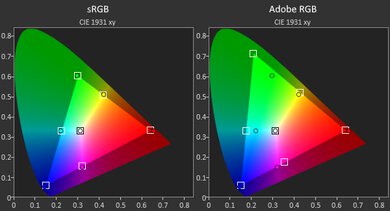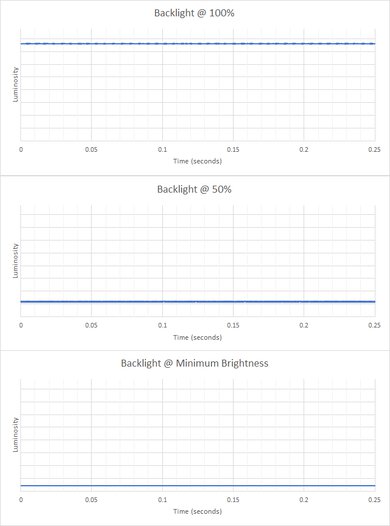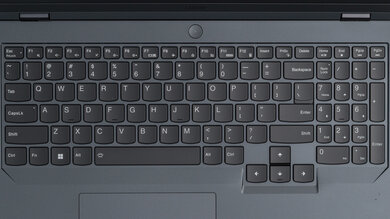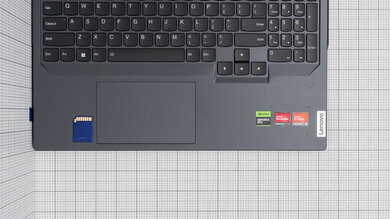The Lenovo Legion Pro 5 Gen 8 16 (2023) is a mid-range gaming laptop. It replaces the Lenovo Legion 5 Pro Gen 7 from 2022. The 2023 model is available with newer Zen 4-based AMD Ryzen 7000 CPUs and NVIDIA RTX 40-series GPUs, ranging from an RTX 4050 to a 4070. It has DDR5 5200MHz RAM and an M.2 PCIe Gen 4 x4 NVMe SSD. Display options include a 165Hz and a 240Hz QHD + (2560 x 1600) IPS panel; both support variable refresh rate to reduce screen tearing. It has Wi-Fi 6E wireless connectivity, a 1080p webcam, and a 78Wh battery. Ports include four USB-As, two USB-Cs, an HDMI 2.1, an Ethernet, and a 3.5mm headphone jack.
You can see our unit's specifications and the available configuration options in the Differences Between Variants section.
Our Verdict
The Lenovo Legion 5 Pro is disappointing for general productivity. Its AMD Ryzen processors can easily handle productivity tasks like web browsing, and thanks to its NVIDIA discrete GPU, you can even edit videos or photos. The display provides plenty of room for multitasking, the keyboard feels comfortable to type on, and the touchpad is reasonably large and responsive. It has a great 1080p webcam for video calls and a wide port selection for peripherals and external displays. The downside is that it's hard to carry around because it's bulky and heavy. Also, its battery lasts less than five hours of light use.
- Sharp, bright display.
- Comfortable keyboard, responsive touchpad.
- CPU and GPU can handle demanding workloads.
- Great 1080p webcam.
- Wide port selection.
- Bulky and heavy.
- Short battery life.
- No Thunderbolt or USB4.
The Lenovo Legion 5 Pro is only okay for media consumption. It isn't very portable because it's bulky and heavy, and its battery lasts less than 4 hours of video playback, so you'll have to bring the charger with you. Its QHD+ display looks very sharp, gets bright enough to combat glare, and is well-calibrated out of the box, so images look accurate and true to life. However, it isn't ideal for dark room viewing, as its low contrast makes blacks look gray. The speakers get reasonably loud with minimal compression but sound unnatural, with almost no bass or treble.
- Sharp, bright display.
- Well-calibrated display.
- Speakers get reasonably loud.
- Flicker-free display.
- Bulky and heavy.
- Short battery life.
- Blacks look gray in dim settings.
- Speakers have very little bass and treble.
The Lenovo Legion 5 Pro is good for gaming. Its AMD Ryzen 7000 CPU and NVIDIA RTX 40-series GPU can push high frame rates to deliver a smooth gaming experience at 1080p or 1440p. The display has a fast response time, resulting in a clear image in fast-moving scenes, and it supports VRR to reduce screen tearing. There's no thermal throttling on the CPU or GPU, so you won't experience any performance loss when gaming for an extended period. However, the fans get pretty loud. The SSD has incredibly fast read speed, which is great for gaming, as it helps reduce loading times. Plus, the storage is user-replaceable, and so is the RAM. The battery lasts only an hour or so when gaming, but on the upside, it charges very quickly.
- CPU and GPU can handle demanding workloads.
- High-refresh display with fast response time and VRR.
- User-replaceable RAM and storage.
- No thermal throttling.
- Gets a little hot and loud under load.
The Lenovo Legion 5 Pro is good for use as a workstation. Its AMD Ryzen 7000 CPUs and NVIDIA RTX 40-series GPUs can easily handle demanding tasks like video editing, programming, and 3D rendering. You can also do some color work, as the display has full sRGB coverage and is well-calibrated out of the box. There's no thermal throttling on the CPU or GPU, but the fans get pretty loud. The SSD is incredibly fast, and like the RAM, it's user-replaceable. Its wide port selection includes an HDMI 2.1 and plenty of USB ports, so you likely won't need a dock; however, neither USB-C ports support Thunderbolt or USB4.
- CPU and GPU can handle demanding workloads.
- User-replaceable RAM and storage.
- Well-calibrated display.
- Wide port selection.
- No thermal throttling.
- Gets a little hot and loud under load.
- No Thunderbolt or USB4.
Changelog
-
Updated Oct 30, 2025:
We've updated text throughout the review after converting to Test Bench 0.9.
- Updated Oct 30, 2025: We've updated the review to Test Bench 0.9, which adds several test boxes in the performance section, including CPU/RAM Performance, Low Tier Graphics, High Tier Graphics, Professional 3D (GPU accelerated), CPU-Intensive Game Performance, GPU-Intensive Game Performance, and Ray Tracing Performance. See the 0.9 changelog here.
- Updated May 07, 2025: We've updated this review to Test Bench 0.8.3, which removes the viewing angle tests and adds a GPU Total Graphics Power comparison in the GPU section. The Pen Input test in the Extra Features section has also changed, as it now shows whether the laptop supports pen input rather than the inclusion of a stylus in the box. See the changelog for more details.
-
Updated Oct 18, 2024:
Added mention of the Razer Blade 18 (2024) as an alternative available with an RTX 4080 and 4090 GPU in the GPU section.
Differences Between Sizes And Variants
We tested the Lenovo Legion Pro 5 Gen 8 (model 82WM0000US) with a 165Hz QHD+ display, an AMD Ryzen 5 7645HX CPU, an NVIDIA GeForce RTX 4050 discrete GPU, 16GB of RAM, and 512GB of storage. The display, CPU, GPU, memory, and storage are configurable; the available options are in the table below. Our review applies only to variants with a model number starting with '82WM'.
| Screen |
|
|---|---|
| CPU |
|
| GPU |
|
| Memory |
|
| Storage |
|
| Color |
|
You can see our unit's label here.
Popular Laptop Comparisons
The Lenovo Legion 5 Pro is among the best gaming laptops in its class. It stands out for its excellent performance, well-calibrated display, and excellent serviceability. However, its lack of Thunderbolt and USB4 support is disappointing.
For more options, check out our recommendations for the best gaming laptops, the best budget and cheap gaming laptops, and the best workstation laptops.
The Lenovo Legion Pro 5 Gen 8 16 (2023) is better than the Lenovo Legion 5 Gen 6 15 (2021). The Legion Pro 5 Gen 8 is available with newer and faster AMD CPUs and NVIDIA GPUs, which can deliver higher frame rates in demanding games. Also, its NVIDIA 40-series GPUs support Frame Generation, an AI-based feature that can dramatically boost performance in supported games. The Legion Pro 5 Gen 8 has a faster 240Hz QHD+ display option, a better 1080p webcam, and a larger 78Wh battery.
The ASUS ROG Zephyrus G16 (2024) GU605 and the Lenovo Legion Pro 5 Gen 8 16 (2023) are both great gaming laptops that provide a similar user experience overall. The ASUS feels more premium, as it has a sturdier build and more compact design. It's available with more powerful Intel Meteor Lake CPUs and higher-end NVIDIA GPUs (RTX 4080 and 4090). That said, the ASUS has some bugs (at the time of writing), limiting its performance in some games.
The Lenovo Legion Pro 5 Gen 8 16 (2023) and the ASUS ROG Zephyrus G14 (2024) are both great gaming laptops available with AMD Ryzen CPUs and NVIDIA 40-series GPUs. The ASUS is a better device for the overall user experience; it has a more premium build, a superior keyboard and touchpad, a longer battery life, and biometrics in the form of a facial recognition IR camera. You can get the Lenovo with a 165Hz or 240Hz QHD+ IPS panel, while the ASUS is only available with a 120Hz 2.8k OLED panel. This means the Lenovo provides smoother motion and better responsiveness when gaming, while the ASUS's OLED panel looks sharper with deeper blacks and punchier colors. Performance-wise, although both laptops are available with the same GPUs (RTX 4050 to 4070), the Lenovo model will push higher frame rates because its GPUs run at a higher wattage of 140W.
The ASUS TUF Gaming A16 (2023) and the Lenovo Legion Pro 5 Gen 8 16 (2023) are both excellent 16-inch gaming laptops. There are many similarities between these two laptops; the only differences have to do with the webcam and port selection, with the Lenovo coming out on top for both. You'll also get better performance out of the Lenovo, as it's available with faster—albeit more power-hungry—CPUs and GPUs. Battery life is the same on both laptops when gaming; however, the ASUS lasts significantly longer in light uses.
Test Results

The Lenovo Legion 5 Pro Gen 8 has a fairly simple design. It has some 'gamer' elements, like the shape of the air vents, branding, and RGB keyboard; however, it doesn't look overly flashy, as the chassis is mostly black and gray. It has thin bezels, and instead of a MacBook-like notch, there's a small outward lip at the top of the screen to house the camera and microphones. Air vents are on both sides of the laptop, the bottom, and the back. The speakers are on the sides near the front.
The build quality is great. The construction is a mix of metal and plastic (aluminum on top and plastic on the bottom). It feels sturdy and hefty, exhibiting only a small amount of flex in the display and almost none on the keyboard deck and lid. The finish doesn't scratch easily; the lid picks up fingerprints and smudges, but this isn't an issue on other parts of the laptop. The feet feel solid and stick firmly to the bottom.
The hinges are outstanding. Their wide range allows you to open the laptop to an almost flat position, which is handy when you need to show something to someone sitting opposite you. They feel very smooth when opening and closing the lid and have just the right amount of resistance to keep wobbling to a minimum while still allowing for a one-handed lift.
The Lenovo Legion Pro 5 and its power adapter are bulky and heavy. Check out the ASUS ROG Zephyrus G16 (2024) GU605 if you want a more compact 16-inch model for on-the-go use.
The Lenovo Legion Pro 5's serviceability is excellent. To access the internals, you need to remove ten Philips screws and undo a few clips. The screws are of two different sizes, so it's best to keep them organized for the reassembly, and you'll likely need a prying tool to undo the clips. Once inside, all the replaceable parts are easily accessible. Both storage slots support M.2 2280 PCIe Gen 4 SSDs.
You can see the service manual here.
The Lenovo Legion Pro 5 is available with the following displays:
- 16" IPS 2560 x 1600 165Hz
- 16" IPS 2560 x 1600 240Hz
The QHD+ resolution looks very sharp on a 16-inch display. The 16:10 aspect ratio is quickly becoming the norm; it doesn't affect gaming much, but it's great for productivity, as the extra vertical space lets you see more information at once when reading a document or website, so you don't have to scroll as much.
The 165Hz display has a fast response time, resulting in a clear image with minimal ghosting in fast-moving scenes. The 240Hz will provide a more responsive gaming experience, but the difference isn't significant. You'll have to pair the 240Hz display with an NVIDIA GeForce RTX 4070 to get the most out of it. Both displays support variable refresh rate to reduce screen tearing. If you want a gaming laptop with a higher refresh display, the Dell Alienware m18 (2023) is available with a 480Hz FHD+ IPS panel.
The 165Hz display's contrast ratio is decent and within the typical range of most IPS panels. However, it's still relatively low compared to other display technologies like VA and OLED. This contrast level makes blacks look gray in dim settings. The 240Hz display likely has the same contrast ratio.
The 165Hz display gets bright enough for use in most indoor environments but is too dim for outdoors in broad daylight. It gets very dim at the lowest brightness settings, which is great for dark room viewing, as it causes less eye strain. The 240Hz display has an advertised brightness of 500 cd/m², which is enough for outdoor use, but you might still have trouble seeing dark-color content in direct sunlight.
The display's reflection handling is decent. Reflections aren't an issue when viewing bright-color content with the screen at maximum brightness; however, they're distracting when viewing darker content, as the matte coating doesn't do much to reduce the intensity of bright light sources and creates a hazy, halo effect in other areas of the screen.
The display's accuracy is superb out of the box. The color and white balance inaccuracies are extremely minor and aren't noticeable. The color temperature and gamma are nearly perfect; the only complaint is that dark scenes look slightly too dark. This level of accuracy is good enough for content color-critical work like photo and video editing.
You can change the display's color profile via the pre-installed X-Rite Color Assistant application. These profiles primarily affect brightness. In the case of the Rec 709 profile, it raises the brightness by 50 cd/m².
The 165Hz display has an excellent color gamut. It has full coverage of the commonly used sRGB color space, which is great for general productivity, media consumption, and gaming. It has excellent DCI-P3 and Adobe RGB coverage, but not enough for professional print photography or HDR video production. The 240Hz display has the same advertised color gamut.
The Lenovo Legion 5 Pro has a great keyboard. The layout feels spacious and is easy to get used to. The plastic used for the keycaps feels okay; it isn't particularly premium or overly cheap. The keys have a lot of travel and provide satisfying tactile feedback; however, their operating force is on the higher side, which can cause fatigue over time, and they aren't very stable. Typing noise is low and isn't bothersome in quiet settings. There are four RGB zones; you can customize the lighting via the Lenovo Vantage application.
The touchpad is good. It's relatively large but could have been bigger, considering the amount of space available on the deck. Although plastic, it still feels high-quality and smooth. It tracks movements and gestures well, and there are no issues with palm rejection; however, dragging and dropping items over a long distance or zooming in and out of images doesn't always work. The buttons feel satisfyingly clicky, but you can only click in the bottom half of the touchpad.
The Lenovo Legion Pro 5's speakers get reasonably loud with minimal compression at high volume. They sound clear and full but slightly unnatural, with very little bass or treble.
The webcam's video quality is great. The overall image looks relatively sharp; however, some finer details look muddy, and there's a bit of noise here and there. Colors look vibrant and true to life, though the color temperature is on the cooler side. Voices sound loud and clear over the microphone with almost no background noise.
The Lenovo Legion 5 Pro has an excellent port selection. The USB-A ports on the sides support USB 3.2 Gen 2 data transfer speed (up to 10Gbps). The two USB-As on the back are USB 3.2 Gen 1 (up to 5Gbps) ports. The one closest to the power connector is always on, meaning you can use it to charge a mobile device or peripheral when the laptop is in sleep mode (up to 10W). Both USB-Cs support USB 3.2 Gen 2 data transfer speed and DisplayPort; the only difference is that the one on the back supports Power Delivery, allowing you to fast charge the laptop and other PD-compatible devices connected to the port.
The Lenovo Legion 5 Pro's wireless adapter is a Realtek RTL8852 Wi-Fi 6E. Wi-Fi 6E has faster speeds, lower latency, and less signal interference than previous Wi-Fi standards. However, you need a router that supports Wi-Fi 6E to benefit from these features.
The Lenovo Legion 5 Pro is available with the following CPUs:
- AMD Ryzen 5 7645HX (6 cores/12 threads, up to 5.0GHz, 6MB L2/32MB L3 cache)
- AMD Ryzen 7 7745HX (8 cores/16 threads, up to 5.1GHz, 8MB L2/32MB L3 cache)
- AMD Ryzen 9 7945HX (16 cores/32 threads, up to 5.4GHz, 16MB L2/64MB L3 cache)
All three are high-performance CPUs designed for mobile workstations and gaming laptops. These AMD Zen 4-based chips can handle general productivity tasks like text processing and web browsing, as well as more demanding workloads like video editing, programming, and gaming. Upgrading to the Ryzen 7 or 9 will give you better performance, though the difference will be minimal in GPU-limited games.
The Lenovo Legion Pro 5 is available with the following GPUs:
- NVIDIA GeForce RTX 4050 Laptop 6GB GDDR6 (140W TGP with Dynamic Boost)
- NVIDIA GeForce RTX 4060 Laptop 8GB GDDR6 (140W TGP with Dynamic Boost)
- NVIDIA GeForce RTX 4070 Laptop 8GB GDDR6 (140W TGP with Dynamic Boost)
The NVIDIA RTX 40-series GPUs aren't a significant upgrade over the 30-series. The most notable addition is a feature called Frame Generation, which uses AI to insert artificially generated frames, resulting in higher frame rates and smoother gameplay in supported games. The RTX 4070 is the fastest and can run games at the display's native QHD+ resolution without many issues; however, you might be unable to max out the graphical settings in the most demanding titles. The RTX 4060 is roughly 20% slower than the 4070; it can handle games at 1440p, but you'll have to lower the settings further to get over 60 fps. The RTX 4050 is mainly a 1080p gaming GPU that can run some games at 1440p. Its 6GB of VRAM is the main limitation, as it isn't enough for demanding games at the QHD resolution. The lack of VRAM will result in stutters and texture pop-ins, meaning some elements take longer to load and seem to appear out of nowhere. You might even experience pop-ins on the RTX 4060 and 4070 in extremely VRAM-heavy games. Check out the Razer Blade 18 (2024) if you want a laptop available with an RTX 4080 or 4090 GPU.
This laptop has a MUX (multiplexer) switch, a feature that allows the GPU to send information directly to the display without going through the integrated GPU. This means you'll see better performance than laptops without this feature. The performance difference can be anywhere from 10% to 25%, or more in some cases. There's also support for NVIDIA Advanced Optimus, which will automatically switch between the integrated graphics and discrete GPU depending on the workload without needing a system reboot or setting change in the BIOS.
You can configure this laptop with 16GB or 32GB of memory. The RAM is user-replaceable.
You can configure this laptop with 512GB or 1TB of storage. The SSD is user-replaceable. There are two SO-DIMM slots; both support M.2 2280 PCIe Gen 4 SSDs.
The Civilization VII - AI test was performed using Vulkan instead of DirectX 12, as the DirectX version was giving results that didn't reflect real-world usage.
The 512GB SSD's performance is outstanding. Its fast read and write speeds allow the system to boot up, launch apps, and transfer files quickly. Its sequential read speed is particularly fast, which is great for gaming as it helps reduce loading times. The 1TB drive is likely faster, as larger-capacity SSDs tend to perform better.
The Lenovo Legion 5 Pro has poor battery life. No matter what you do, you'll have to plug it in to get through a full day. On the upside, it charges very quickly. Models with a 240Hz display will have shorter battery life.
The keyboard feels warm under load, but it isn't uncomfortable. The fans, on the other hand, get fairly loud. With the Performance mode and GPU Overclock enabled, the keyboard temperature rises slightly to 46.7 °C, and the fans get a few dBA louder, producing a higher-pitched noise that can be pretty annoying. The Lenovo Vantage application has a couple of fan profiles, including a Quiet Mode that will lower the fan noise at the cost of some performance loss.
The Lenovo Legion 5 Pro's performance over time is superb. Neither the CPU nor the GPU throttles under load. The Performance mode results are the same.
The Lenovo Legion 5 Pro has many pre-installed applications, including:
- Dolby Vision: Adds Dolby Vision support.
- Legion Arena: Game hub that lets you launch games from multiple platforms.
- Lenovo Hotkey: Lets you create hotkeys and macros.
- Lenovo Now: Ads for Lenovo Support Services, like Accidental Damage Protection and Smart Lock (remote lock and data wipe). It also contains ads for Amazon Music, Dropbox, Adobe Acrobat, and Lenovo accessories.
- Lenovo Vantage: Helps keep the BIOS and drivers up to date. It also lets you view the system's status and warranty information and access various power profiles.
- McAfee: Antivirus software.
- Nahimic: SteelSeries-branded audio customization and configuration utility.
- Nahimic Companion: Audio drivers. It also checks for updates to the Nahimic application.
- Solitaire and Casual Games: Solitaire, FreeCell, Spider, Mahjong, Sudoku, and other casual games.
- Tobii Experience: Eye and head tracking software. It lets you control the camera in some games, blurs the screen when you aren't looking directly at it, and lowers the screen brightness when you aren't in front of the laptop.
- X-Rite Color Assistant: Lets you change the color profile and calibrate the display.






















